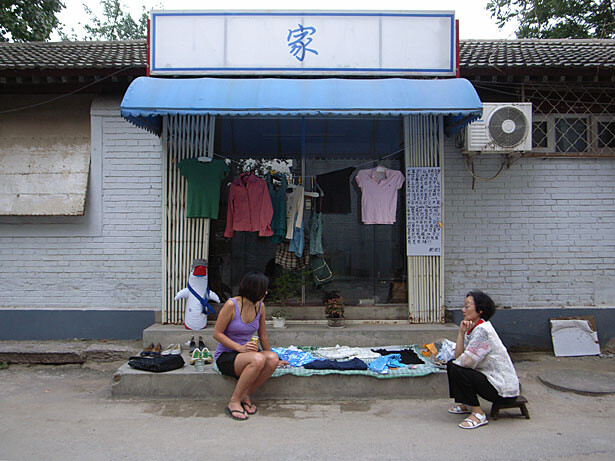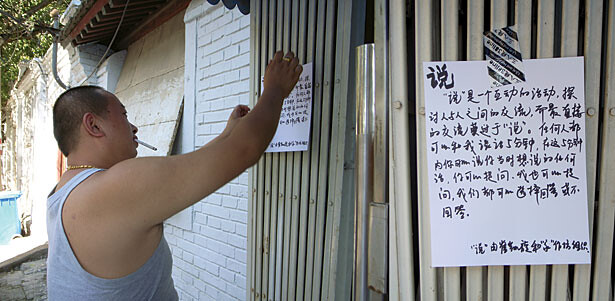I recently received a call from a young artist based in Guangzhou. He spoke excitedly about a space he is launching soon with two artist friends from the same region. At a time when more art venues than ever are shutting down, such a move really seems to go against the tide. Further discussion revealed the simplicity of their vision: to establish a platform upon which they can put their thinking into practice, without being bound by anything other than their own creative urges, without having to measure results according to any pragmatic criteria.
Aptly named “The Observers Association,” such an initiative sets itself apart from the considerable number of lofty galleries and art spaces that have mushroomed throughout China over the past five years. Their rent is low. Their budget is minimal and consists of contributions from each of the three founders. They have even reached an agreement by which whoever sells his or her work elsewhere will voluntarily contribute 10% of the income to the operation of the space. There is only one goal: to keep the space going so that they can exhibit their own work, make their own projects, and have a space for free experiments and intellectual exchange. The three founding members are two artists and one curator, all of whom look forward to treating this space as the playground for their own practices. They contribute equally to the space and share responsibilities in accordance with their individual strengths. They emphasize fairness, so that each has an equal opportunity to use the space. Although Guangzhou seems far removed from the dominant gallery systems of its northern counterparts in Beijing and Shanghai, the artists from this area can still feel the commercial forces and pressures that have shaped the art world in China. “It’s a prospect all too familiar and foreseeable. I can imagine what I would become and what I would receive if I were willing to become a gallery artist,” this artist remarked. “I want to find a new way.”


The HomeShop stoop sale brings neighbors and friends to HomeShop. Courtesy HomeShop.
Such reflections would have been inconceivable ten years ago. Even one of the earliest darlings of the Chinese art market, Fang Lijun, admitted that he had not had any experience working with a gallery and didn’t know a thing about the art market when he was picked up by a gallerist after appearing at the famed China Avant-garde exhibition in 1989. The burgeoning art market has produced an enormous amount of optimism and temptation in the past decade surrounding the production and dissemination of art in China, yet the unconditional passion for art found in the early movements and artist groups, and in heated debates across the country in the 1980s, has been all but drowned out by the noise of that market. Founded on idealism and innocence prior to the introduction of monetary interests in art, that passion seems somewhat remote today, now that we are more sophisticated and aware of the intricate makeup of the art system and the kind of power games money fuels within it. Such awareness provides us with a completely different set of dynamics for artist initiatives and autonomous art projects, and at the same time poses a new set of questions and challenges.
Take the Observers Association, for instance: the model might not be new—it’s an artist-run space—yet it was born as a response to the specific situation in China, where there is on the one hand an obsession with constructing the physical infrastructure for large exhibitions, museum structures, and state-of-the-art facilities; on the other, there is a staggering shortage of theoretical engagement and context-specific artistic experiments at all levels. As the rush to write the ultimate contemporary art history for China continues to play out in shows claiming either to define the masters or to offer a certain historiography of the last few decades, a power-hungry and somewhat functionalist ambition is, more often than not, coupled with ignorance regarding the special nature of art and knowledge production as something lying beyond actual and material production. After all, art is a special language, with regard to both its acquisition and to its role in communication, and it is not enough to give it a well-adorned physical home. Rather, it requires in-depth intellectual input and engagement—it must be critically examined, challenged, debated, redefined, and reinvented. The fundamental drives to make and work with art have somehow become lost in the glamour and power bestowed by the market on its active players. Such a loss has become especially glaring amidst the recent collapse of the art market. The market has stopped providing artists with a constant affirmation of their success. It’s real: it has become harder to sell work and the number of studio visits has dropped significantly; many are confused and anxious. What now?


Flyer for a Small Productions barbeque. Names of the participating artists are listed on the hot dogs.
Courtesy Small Productions.
Where money might once have offered a solution, now the answer might be less tangible. Small Productions, an autonomous artist initiative based in Hangzhou, was started by a small group of recent art school graduates and young artists out of frustration with the pressures of exhibitions, production budgets, the formality of presenting artwork, the market, and, above all, the dearth of real exchange and debate amongst artists. First announced in December 2008, Small Productions’ manifesto is written in a personal, earnest, and quietly inflammatory manner. 1 Choosing to remain collective rather than individual, anonymous rather than self-important, the founders expressed their heartfelt desire to overcome the obstacles to artistic practice presented by cutbacks in financial support or sporadic production budgets, by having their artistic aspirations short-changed by external limitations.
“Small Productions, Don’t Stop!” is the motto they propose and stick to. In a mere few months they hosted seven events in which young artists came and brought any work of art they made. Most of these were just one-day events, with no overriding themes or fixed venues. Sometimes artists gathered casually over barbeque or a potluck dinner, and artworks were just something they brought along. There are no criteria for, or pre-selection of, works in these exhibitions. They take place in artist studios, deserted warehouses, galleries, or on the Web. The emphasis is clearly on involving as many people as possible, encouraging artists to make and show work without inhibition or practical concern, giving all works and ideas a place to be seen, and, more importantly, a place for the exchange of opinion. Exhibition openings become artist gatherings and venues for discussions concerning both exhibited works and issues artists seek to address in their own work.


Another flyer for a Small Productions event featuring their motto “Small Productions, Don’t Stop!” Courtesy Small Productions.
Small Productions is all about creating a relaxed, open, and stimulating environment where young artists can test their ideas without constraint or fear of failure. The works shown at these gatherings tend to be modest in scale, production cost, and appearance—fragile, ephemeral, humorous, everyday, unsophisticated, and even a bit naïve, often resembling what schoolchildren might make in handicrafts classes. Yet these small ideas contain an unstoppable enthusiasm that is exactly the starting point for this concept. These artists believe in the power of doing and in exploring possible models of working and exhibition-making without the idea of art as a “business.” Forget about having to show work properly and in the right context. Go with instinct and look for new coordinates by which to situate and substantiate artistic experiments.
Whereas Small Productions seems to be a conceptually fluid experiment taking place in an explicit art context, HomeShop in Beijing was born with a very specific physical and conceptual framework, providing a stage for a series of community-based, outward-reaching projects related to its unique urban residential setting. Working out of the twelve-square-meter living room of her storefront in Xiaojingchang Hutong, an alley in the old part of the city, Elaine W. Ho, a Chinese American artist currently based in Beijing, uses the everyday life of this specific location as HomeShop’s point of departure and subject matter, engaging a diverse range of contributors. Architects, theorists, visual artists, writers, musicians, and, above all, the local residents each bring something to the pot: the opening ceremony of the Beijing Olympic Games is projected on HomeShop’s façade for the local residents; a reading and discussion group is invited to have their event in HomeShop; Chinese herbal plum juice is shared with the hutong residents; Cassidy Cui, a curator and writer, invites anyone to speak with her about anything for five minutes; a selection of movies is screened; a journal entitled “Wear” is published to document the complexity and richness of HomeShop projects. HomeShop is as elastic as nylon stockings, stretched as far as its projects allow. Some of its events are extremely ambiguous in nature and seemingly far-fetched: are they art events or something else? Maybe they can be both, just as HomeShop is itself both a private home for Ho and a public space of production for those involved. HomeShop is yet to receive much recognition and acclaim within art circles, but there is definitely space for such an endeavor.


Next door neighbour Zheng helps put up the sign inviting participants for HomeShop’s “Speak” activity. Courtesy HomeShop.
Excitement is building, with no formal press release, no art jargon, no market glamour, no hierarchy. HomeShop in Beijing, Small Productions in Hangzhou, and the Observers Association in Guangzhou are all self-sufficient, independent, conceptually ambitious, low-budget, and flexible. They are immune to the commercial uncertainty of the art system and empowered by new artistic visions and achievements. However, though they may suggest alternate paradigms for artistic and exhibition models, the market remains very much the primary site for the production and contemplation of art in China at the moment, and this obscures initiatives that fail to generate any immediate commercial activity or profit. Most curators and critics here are unable to engage with such practices, and tend to dismiss them as too marginalized and vernacular for their rejection of mainstream forms. But just as the manifesto of Small Productions suggested, “Small Productions is a big them.” Such productions respond to very specific concerns arising from artists’ and curators’ practices, connecting them to specific contexts, whether geographical or theoretical. Their existence doesn’t affirm common knowledge, but raises as much doubt as it does interest. After all, this is only the beginning. We hope that it doesn’t stop here.
Read Zhang Liaoyuan’s Small Productions manifesto here: →.
